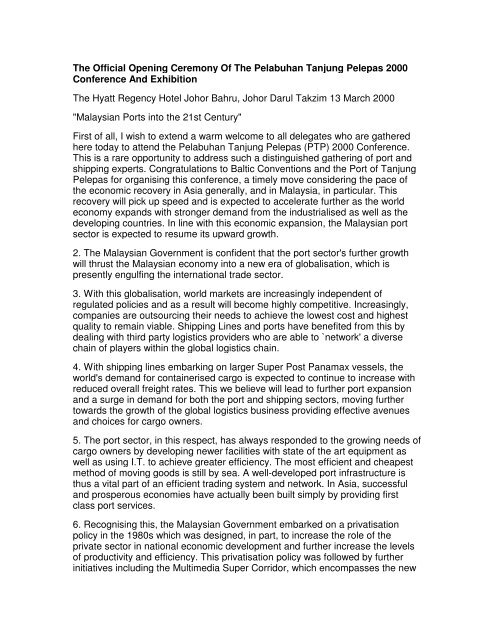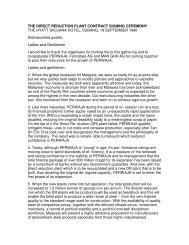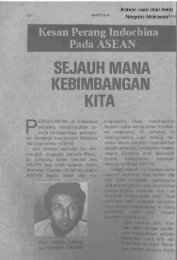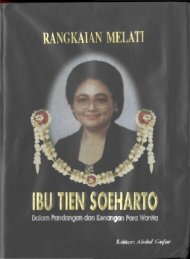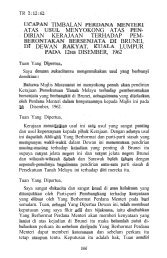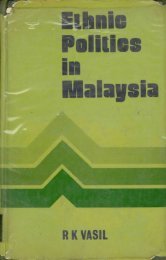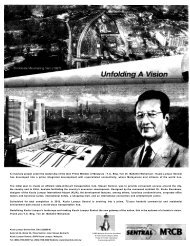The Official Opening Ceremony Of The Pelabuhan Tanjung Pelepas ...
The Official Opening Ceremony Of The Pelabuhan Tanjung Pelepas ...
The Official Opening Ceremony Of The Pelabuhan Tanjung Pelepas ...
Create successful ePaper yourself
Turn your PDF publications into a flip-book with our unique Google optimized e-Paper software.
<strong>The</strong> <strong><strong>Of</strong>ficial</strong> <strong>Opening</strong> <strong>Ceremony</strong> <strong>Of</strong> <strong>The</strong> <strong>Pelabuhan</strong> <strong>Tanjung</strong> <strong>Pelepas</strong> 2000<br />
Conference And Exhibition<br />
<strong>The</strong> Hyatt Regency Hotel Johor Bahru, Johor Darul Takzim 13 March 2000<br />
"Malaysian Ports into the 21st Century"<br />
First of all, I wish to extend a warm welcome to all delegates who are gathered<br />
here today to attend the <strong>Pelabuhan</strong> <strong>Tanjung</strong> <strong>Pelepas</strong> (PTP) 2000 Conference.<br />
This is a rare opportunity to address such a distinguished gathering of port and<br />
shipping experts. Congratulations to Baltic Conventions and the Port of <strong>Tanjung</strong><br />
<strong>Pelepas</strong> for organising this conference, a timely move considering the pace of<br />
the economic recovery in Asia generally, and in Malaysia, in particular. This<br />
recovery will pick up speed and is expected to accelerate further as the world<br />
economy expands with stronger demand from the industrialised as well as the<br />
developing countries. In line with this economic expansion, the Malaysian port<br />
sector is expected to resume its upward growth.<br />
2. <strong>The</strong> Malaysian Government is confident that the port sector's further growth<br />
will thrust the Malaysian economy into a new era of globalisation, which is<br />
presently engulfing the international trade sector.<br />
3. With this globalisation, world markets are increasingly independent of<br />
regulated policies and as a result will become highly competitive. Increasingly,<br />
companies are outsourcing their needs to achieve the lowest cost and highest<br />
quality to remain viable. Shipping Lines and ports have benefited from this by<br />
dealing with third party logistics providers who are able to `network' a diverse<br />
chain of players within the global logistics chain.<br />
4. With shipping lines embarking on larger Super Post Panamax vessels, the<br />
world's demand for containerised cargo is expected to continue to increase with<br />
reduced overall freight rates. This we believe will lead to further port expansion<br />
and a surge in demand for both the port and shipping sectors, moving further<br />
towards the growth of the global logistics business providing effective avenues<br />
and choices for cargo owners.<br />
5. <strong>The</strong> port sector, in this respect, has always responded to the growing needs of<br />
cargo owners by developing newer facilities with state of the art equipment as<br />
well as using I.T. to achieve greater efficiency. <strong>The</strong> most efficient and cheapest<br />
method of moving goods is still by sea. A well-developed port infrastructure is<br />
thus a vital part of an efficient trading system and network. In Asia, successful<br />
and prosperous economies have actually been built simply by providing first<br />
class port services.<br />
6. Recognising this, the Malaysian Government embarked on a privatisation<br />
policy in the 1980s which was designed, in part, to increase the role of the<br />
private sector in national economic development and further increase the levels<br />
of productivity and efficiency. This privatisation policy was followed by further<br />
initiatives including the Multimedia Super Corridor, which encompasses the new
administrative capital of Putrajaya and the KL International Airport. This area,<br />
once fully developed, will see the state-of-the-art Information Technology<br />
infrastructure and new business-friendly procedures and regulations to attract<br />
I.T. - based industries. With these business-friendly approaches, procedures<br />
such as Customs and Immigration clearance have today undergone some form<br />
of computerisation, which has provided for EDI links to external users. This has<br />
also helped to enhance the attractiveness of Malaysian ports due to faster<br />
turnaround of vessels through simple and effective clearance procedures.<br />
7. <strong>The</strong> Port of <strong>Tanjung</strong> <strong>Pelepas</strong> (PTP), which was developed following a<br />
privatisation agreement with the Government of Malaysia in March 1995 has<br />
benefited from these procedures. Being new, PTP has geared itself to be the<br />
commercial nexus of South East Asia, offering port solutions that are reliable,<br />
efficient and advanced. With this goal in mind, this conference and exhibition is<br />
necessary to create an international forum where participants can exchange<br />
ideas, views and learn the latest on port management and issues relevant to<br />
their countries. In a continued effort to upgrade and improve the Malaysian<br />
economy, this conference and exhibition will be a biennial event.<br />
8. Strategically situated at the confluence of international shipping lanes with just<br />
45 minutes navigation time away, PTP sees itself as offering a viable and<br />
alternate port of call to shipping lines in this region. Located on 1,935 acres of<br />
greenfield site, PTP will enhance Malaysia's port sector's contribution to<br />
Malaysia's development.<br />
9. PTP aspires to develop into a regional transhipment hub and aims to be on<br />
par with existing international ports like Singapore and Hong Kong. With a stateof-the-<br />
art Information Technology system, PTP gives instant access to its<br />
purpose-designed Integrated Terminal and Port Management Information<br />
System (ITPMIS). By synergising the Port's operations and communication<br />
centres, the ITPMIS facilitates a free-flow of updated information and provides<br />
near paper-less transactions between port personnel, shipping lines, marine<br />
services and freight forwarders.<br />
10. PTP spares no expenses in providing the latest Super Post Panamax and<br />
Post Panamax Container Quay cranes to be deployed on the quayside. <strong>The</strong>ir 53metre<br />
outreach can service even the most sophisticated container vessel. Along<br />
with Rubber-Tyred Gantry cranes, Prime Movers and Trailers, PTP reduces<br />
turnaround time as cargo moves efficiently and quickly.<br />
11. Challenging conventional and traditional views of port development, PTP<br />
offers an ideal opportunity for customers to reshape the market. Various customs<br />
formalities like Deferment of Duty on foreign goods until departure and<br />
Elimination of Duty on merchandise re-exported, have been waived. PTP also<br />
provides facilities for storage of goods and merchandise pending more<br />
favourable market/sales conditions.<br />
12. Southwest Johore is a growing area offering cheaper and cost-effective<br />
alternatives to manufacturing and commercial industries. About 1,000 acres of
land are available for lease on a long-term basis. Designed as a container port,<br />
PTP will develop a Distripark, ideal for warehousing consolidation, International<br />
Procurement Centre operations, value-added activities and distribution services.<br />
For port and maritime-related support industries, PTP has reserved some 613<br />
acres of land to accommodate export-oriented light, medium and heavy<br />
industries.<br />
13. PTP will have the single largest container handling facilities in the region<br />
outside of Singapore. Spanning an area of 1.2 million square metres and able to<br />
store approximately 110,000 TEUs, the container yard is one of the largest in<br />
South East Asia.<br />
14. <strong>The</strong> increase in trade would have an impact on ports and shipping services.<br />
<strong>The</strong> maturing of new container markets following the admission of Vietnam,<br />
Cambodia, Myanmar and Laos would open up vast opportunities for new ports to<br />
play a bigger role in the region. PTP is therefore in a good position to provide a<br />
better platform for Malaysia to capture these growing markets.<br />
15. In an increasingly competitive environment, port operators must ensure that<br />
the needs of users are met. Through the Malaysia Incorporated concept,<br />
Government and private sectors have been able to work together to develop the<br />
port sector and achieve greater heights.<br />
16. In line with the theme of this conference, an awareness of the potential of<br />
PTP will become more apparent. I hope participants here will discuss and<br />
exchange ideas for the betterment of local ports industry. <strong>The</strong> conference will<br />
also analyse global and regional trade and shipping trends in this new millenium<br />
that are relevant and that would have direct impact on the port industry. I believe<br />
that deliberations from this conference would provide useful guidelines and<br />
directions in ensuring effective and dynamic port policies, thereby enabling local<br />
ports to remain competitive and attractive in a fast changing world.<br />
17. On this note, I hereby declare the PTP 2000 International Conference and<br />
Exhibition open.


